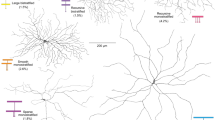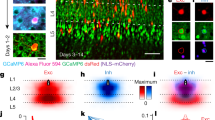Abstract
NEURONS in the primary visual cortex respond selectively to the orientation of edges and their direction of motion. Orientation preference is mapped in a systematic fashion across the cortical surface, such that neurons in adjacent columns have similar but slightly shifted preferred orientations1–7. Microelectrode studies have suggested that direction preference is also arranged in a systematic fashion8–10, but exactly how this response property is mapped remains unclear. Here we show by optical imaging4–5 of intrinsic signals6–7,11–14 in ferret cortical area 17 that there is a mosaic-like map of direction preference. This map consists of numerous regions within which direction preference changes in a slow, continuous fashion. These regions are separated by winding boundaries (fractures) across which direction preference shifts abruptly, often by 180 °. Comparison of direction and orientation preference maps shows that these fractures subdivide iso-orientation domains into regions selective for opposite directions of motion.
This is a preview of subscription content, access via your institution
Access options
Subscribe to this journal
Receive 51 print issues and online access
$199.00 per year
only $3.90 per issue
Buy this article
- Purchase on Springer Link
- Instant access to full article PDF
Prices may be subject to local taxes which are calculated during checkout
Similar content being viewed by others
References
Hubel, D. & Wiesel, T. N. J. Physiol., Land. 195, 215–243 (1968).
Hubel, D. & Wiesel, T. N. J. comp. Neurol. 158, 267–294 (1974).
Hubel, D. & Wiesel, T. N. Proc. R. Soc. Lond. B 198, 1–59 (1977).
Blasdel, G. G. & Salama, G. Nature 321, 579–585 (1986).
Blasdel, G. G. J. Neurosci. 12, 3115–3138 (1992).
Bonhoeffer, T. & Grinvald, A. Nature 353, 429–431 (1991).
Bonhoeffer, R. & Grinvald, A. J. Neurosci. 13, 4157–4180 (1993).
Payne, B. R., Berman N. & Murphy, E. H. Brain Res. 211, 445–450 (1981).
Tolhurst, D. J., Dean, A. F. & Thompson, I. D. Expl Brain Res. 44, 340–342 (1981).
Swindale, N. V., Matsubara, J. A. & Cynader, M. S. J. Neurosci. 7, 1414–1427 (1987).
Frostig, R. D., Lieke, E. E., Ts'o, D. Y. & Grinvald, A. Proc. natn. Acad. Sci. U.S.A. 87, 6082–6086 (1990).
Weliky, M. & Katz, L. C. J. Neurosci. 14, 7291–7305 (1994).
Weliky, M., Kandler, K., Fitzpatrick, D. & Katz, L. C. Neuron 15, 541–552 (1995).
Malonek, D., Tootell, R. B. H. & Grinvald, A. Proc. R. Soc. Lond. B 258, 109–119 (1994).
Swindale, N. V. Proc. R. Soc. Lond. B 215, 211–230 (1982).
Braitenberg, V. & Braitenberg, C. Biol. Cybern. 33, 179–186 (1979).
Fitzpatrick, D., Schofield, B. R. & Strote, J. Soc. Neurosci. Abstr. 20, 837 (1994).
Author information
Authors and Affiliations
Rights and permissions
About this article
Cite this article
Weliky, M., Bosking, W. & Fitzpatrick, D. A systematic map of direction preference in primary visual cortex. Nature 379, 725–728 (1996). https://doi.org/10.1038/379725a0
Received:
Accepted:
Issue Date:
DOI: https://doi.org/10.1038/379725a0
This article is cited by
-
Primary Visual Cortex Modules in Mammals
Neuroscience and Behavioral Physiology (2023)
-
Does experience provide a permissive or instructive influence on the development of direction selectivity in visual cortex?
Neural Development (2018)
-
Distributed network interactions and their emergence in developing neocortex
Nature Neuroscience (2018)
-
Orientation selectivity and the functional clustering of synaptic inputs in primary visual cortex
Nature Neuroscience (2016)
Comments
By submitting a comment you agree to abide by our Terms and Community Guidelines. If you find something abusive or that does not comply with our terms or guidelines please flag it as inappropriate.



